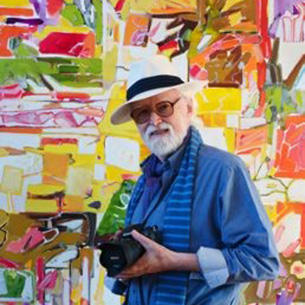Biography
Try this experiment. Close your eyes, remember a favourite place (landscape, street, garden, room), and picture it for a while.
What did you really see, in memory? A photograph of sorts, incomplete, yes, but true in proportion, arrangement, colour? Or were the salient shapes larger than life? More intense in colour, more prominent? Spotlit, as it were?
Every time I look or look again at one of Derek Balmer’s paintings, it strikes me (as it may strike you) that this picture is not necessarily a likeness of the place but like a memory of being there, in that light. It does what memory does – select, scramble, vivify, enjoy. That is why his work flirts with abstraction. He is abstracting the memory of what made it a good place to be, to see. He follows Picasso’s dictum about drawing: You must close your eyes and sing.
Enjoyment, in the deep, physical sense, is a component of every Balmer painting. Such shapes, so generously handled. Such colours, sometimes so like a carnival in their vibration that you could suspect a trace of self-mockery, commenting on itself: see how far I can intensify the natural world and yet it remains a version of something seen. It is a magnificat.
Any organic thing under a microscope discloses shapes as strange as abstraction can imagine. Seeds, for instance – once a characteristic Balmer motif – are often odd, unnatural in appearance. It’s a process to which he returns, painting the creation of the world, not its fixed properties. He is in the line of Blake. His paintings can be like a shout of joy.
More recently he has been given to ‘summarizing whole civilizations through their buildings’, to quote Andrew Lambirth: usually ancient, hieratic buildings, in Mediterranean settings. He uses his brush to improvise around a theme, building up complex textures. What resolves them, buildings or landscapes, is often a grid pattern, a rhythm on which his improvisation depends.
I have been enjoying his paintings, and his friendship, for fifty years. I associate him with the exhilaration of the 1960s – call it irreverence, or exuberance. When I speak of ‘pictures of memory’, I have in mind the Vaucluse in 1962, as I watched him at work on a couple of paintings. I know that landscape well, and those paintings still capture almost the smell of the place.
Balmer made a successful career in photography (helped by being monocular, like a camera, he told me), but has returned, joyously, to painting full-time. Not just his own painting. For the past ten years he has been a very effective President of the Royal West of England Academy in Bristol. He dresses the part, but for him it has been no figurehead position. He has made an active difference in the quality of the exhibitions at the academy. He has enriched its permanent collection.
‘We are in the presence of art which offers us a greater understanding of the world’s glories . . . Why is Balmer not better known?’ Andrew Lambirth asks. One reason is the price an artist pays for happily living and working in Bristol, outside the metropolitan limelight. ‘If I were advising anyone on making a collection of contemporary British art, I wouldn’t hesitate to recommend ‘The Road to Marathon’ (1998)’, Lambirth writes. In ‘Lavender Field: Provence’ of 2006 we come up to date with an artist working at the height of his powers.

